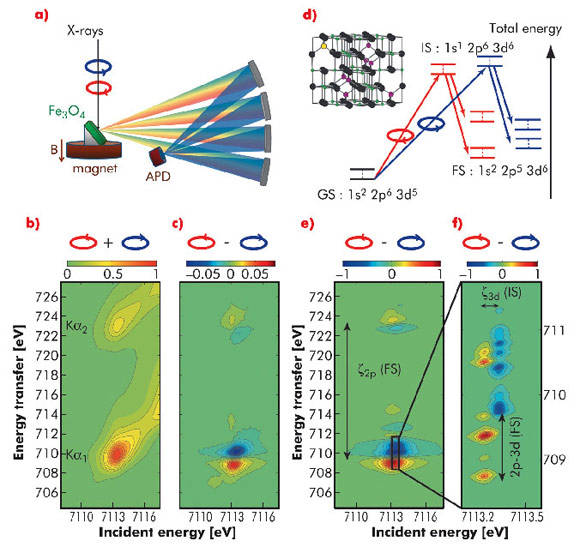- Home
- Users & Science
- Scientific Documentation
- ESRF Highlights
- ESRF Highlights 2010
- Dynamics and extreme conditions
- Strong K-edge magnetic circular dichroism in 1s2p RIXS
Strong K-edge magnetic circular dichroism in 1s2p RIXS
X-ray magnetic circular dichroism (XMCD) is a powerful tool for the element-specific study of the magnetic structure of complex systems [1]. The spin and orbital polarisation of 3d valence orbitals is conveniently studied by dipole-allowed 2p → 3d transitions, i.e. L-edge absorption spectroscopy in the soft X-ray range. Most soft X-ray XMCD measurements are performed using total electron yield because significant self-absorption effects are observed when using total fluorescence yield detection. Thus, L-edge XMCD is mainly sensitive to the sample surface and, in addition, it is not compatible with demanding sample environments such as high-pressure cells. Hard X-rays are used at the K-edge but the very weak XMCD signal and the absence of spin-orbit split edges do not allow a detailed quantitative interpretation. Hence there is a need for a magnetic spectroscopy in the hard X-ray range that can provide information on the ordering and the value of 3d magnetic moments. This goal can be achieved by coupling XMCD with 1s2p resonant inelastic X-ray scattering (RIXS) at the K pre-edge.
RIXS is a second-order optical process where first a core hole in a deep electron shell is created (intermediate state) that is then replaced by a shallower hole (final state). This results in sharper spectral features and often a rich multiplet structure that reveals electron-electron and spin-orbit interactions [2]. The 1s2p RIXS probes the evolution of the Ka emission (2p → 1s) following resonant excitation of a 1s electron. The K-edge absorption spectra of most 3d transition metal (TM) compounds show weak pre-edge features that are sensitive to the valence orbitals and are predominantly composed of the 3d density of unoccupied states. The 2p53dn+1 final state electron configuration in 1s2p RIXS is identical to the 2p spin-orbit split L2,3 absorption edges. The idea of our work was to combine a bulk sensitive hard X-ray probe with the MCD sensitivity of a 2p (L-edge) core hole, i.e. to perform 1s2p RIXS at the K absorption pre-edge in 3d TM using circularly polarised X-rays.
1s2p RIXS-MCD experiments were performed at beamline ID26 at room temperature on magnetite [FeIII]tetra[FeIIFeIII]octaO4 (Figure 17a). The experimental RIXS-MCD plane, plotted as the difference between left and right circularly polarised light, reveals a strong dichroic signal (Figure 17c). The comparison with the RIXS plane averaged over the two photon helicities (Figure 17b) shows that only the resonant features give rise to the XMCD. The experimental data are compared with the theoretical RIXS-MCD calculated within the crystal field multiplet approach (Figure 17d), assuming a dominant contribution of tetrahedral FeIII. Good agreement between theory and experiment is achieved. The RIXS-MCD amplitude is as large as 16% and comparable to L-edge absorption MCD. Calculations show that the enhancement of the XMCD signal in RIXS is a result of increased splitting of the XMCD spectral features in the 2p53dn+1 final state and the smaller lifetime broadening of the 2p as compared to the 1s core hole.
An interesting aspect of RIXS-MCD is the possibility of site-selective measurements in mixed valence and multisite compounds. As incident and emission energies depend on the oxidation state of the absorber, it is possible to increase the selectivity by tuning either of these, for example, at 7012 eV incident and 707 eV transfer energy (Figure 17c), to study the magnetic behaviour of octahedrally coordinated FeII in magnetite. This opens new opportunities for earth sciences and condensed matter physics, allowing for truly bulk sensitive, element- and site-selective measurements of 3d TM magnetic moments and their ordering under demanding sample environments.
Principal publication and authors
M. Sikora (a), A. Juhin (b,c), T.-C. Weng (c,d), P. Sainctavit (e), C. Detlefs (c), F. de Groot (b) and P. Glatzel (c), Phys. Rev. Lett. 105, 037202 (2010).
(a) AGH University of Science and Technology, Krakow (Poland)
(b) Utrecht University (The Netherlands)
(c) ESRF
(d) currently at: SSRL, Stanford (USA) (e) IMPMC, Université Pierre et Marie Curie, Paris (France)
References
[1] E. Beaurepaire et al., Magnetism: A Synchrotron Radiation Approach (Springer, Berlin Heidelberg 2006).
[2] F. de Groot and A. Kotani, Core Level Spectroscopy of Solids (CRC Press, Boca Raton 2008); P. Glatzel and U. Bergmann, Coord. Chem. Rev. 249, 65 (2005).




